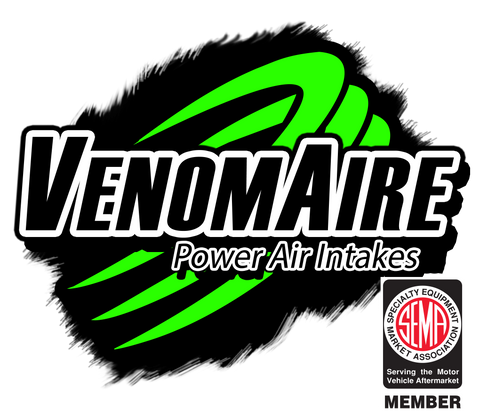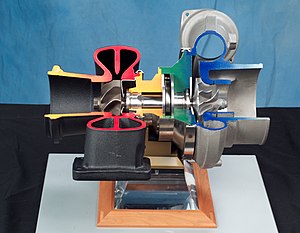A brief history of Forced Air Intakes

Turbocharger
A turbocharger, colloquially known as a turbo, is a turbine-driven, forced induction device that increases an internal combustion engine's efficiency and power output by forcing extra compressed air into the combustion chamber.[1][2] This improvement over a naturally aspirated engine's power output is due to the fact that the compressor can force more air—and proportionately more fuel—into the combustion chamber than atmospheric pressure (and for that matter, ram air intakes) alone.
Turbochargers were originally known as turbosuperchargers when all forced induction devices were classified as superchargers. Today, the term "supercharger" is typically applied only to mechanically driven forced induction devices. The key difference between a turbocharger and a conventional supercharger is that a supercharger is mechanically driven by the engine, often through a belt connected to the crankshaft, whereas a turbocharger is powered by a turbine driven by the engine's exhaust gas. Compared with a mechanically driven supercharger, turbochargers tend to be more efficient, but less responsive. Twincharger refers to an engine with both a supercharger and a turbocharger.
Manufacturers commonly use turbochargers in truck, car, train, aircraft, and construction-equipment engines. They are most often used with Otto cycle and Diesel cycle internal combustion engines.
traditional Forced Air Intakes have come in basically two different types-Turbochargers and Superchargers. Many different shapes, styles and varieties have been developed over the years, yet little has changed in their function.
Both Turbo and Superchargers are considered High Pressure Low Volume systems-they work by compressing air into the cylinders, either via a mechanical device (supercharger) or high speed turbine running off exhaust gas (turbo charging.)
These designs have a myriad of design problems and are expensive to install and maintain, often voiding the manufactures warranty.
VenomAire has introduced a third type of Forced Air Intake-the Hybrid Forced Air Intake-known as the VenomAire Hybrid Forced Air Intake or VENOM2XS. The VENOM2XS Turbine Air Intake, is a Low Pressure-High Volume, Computer Controlled, Multiple Spool, Axial Compressor. The VENOM2XS monitors and adjusts the mass air intake of combustion engines and interacts with the engine's throttle for a smooth blend of impeccable performance, fuel economy and thus reducing pollution.
Product Claims
- Improved performance and drive ability
- Improved fuel mileage
- Reduced emissions
- Does not void manufactures warranty
- Pays for itself while reducing environmental impact


Comments
Ron Beck said:
Have you installed this on Cummins 6.7 turbo diesel? What were results?
Thanx
Ron
Anonymous said:
Ron;
Yes, we have done some preliminary testing on diesels. The results are far better than expected. Most notable is reduction of turbo lag. Feels more like a normally aspirated engine when accelerated. There is an increase in boost pressure, a larger than expected fuel mileage improvement, reduced black smoke and reduction in EGTs, to name a few.
-Dan
Ken said:
I’m interested in putting this on my 8.1 Chevy 2500hd ,what should I expect to gain??
Anonymous said:
Ken;
When ordering for the Chevy 8.1, use Yukon, Sierra, Avalanche, Yukon – 5.3, 5.7, 6.0, 6.2 gas engines. They will work and fit the 8.1 and give the same benefits!
-dan
Anonymous said:
Ken;
The 8.1 Chevys similar to the 6.0 liter engines. Reports have been given of 2-3 mpgs and of course bottom end pulling power. These motors seem to lack decent air into the intakes and it is vastly improved with the Venom2XS. I’m sorry, I don’t have dynos on every make and model, but enough have been done that I can say you will at least get about 20 more horse power and 50 lbs in torque. No guarantees, on those gains, since I don’t know about your gearing, tires sizes and all the variables. But it will be very noticeable.
-d